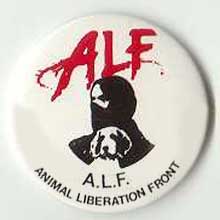https://www.haytap.org/tr/the-animal-liberation-front-alf
The Animal Liberation Front (ALF)
The Animal Liberation Front (ALF) is a name used internationally by animal liberation activists who engage in direct action on behalf of animals. This includes removing animals from laboratories or fur farms, and sabotaging facilities involved in animal testing and other animal-based industries. According to ALF statements, any direct action that furthers the cause of animal liberation, where all reasonable precautions are taken not to endanger life, may be claimed as an ALF action.[2]
The Animal Liberation Front (ALF) is a name used internationally by animal liberation activists who engage in direct action on behalf of animals. This includes removing animals from laboratories or fur farms, and sabotaging facilities involved in animal testing and other animal-based industries. According to ALF statements, any direct action that furthers the cause of animal liberation, where all reasonable precautions are taken not to endanger life, may be claimed as an ALF action.[2]
The ALF is not a group with a membership, but an example of a leaderless resistance, which sees itself as the modern-day equivalent of the Underground Railroad,[3] with activists removing animals from laboratories and farms, finding safe veterinary care for them, arranging safe houses, and operating sanctuaries where the animals live out the rest of their lives.[4] Covert cells, currently active in around 35 countries,[5] operate clandestinely and independently of one other, with activists working on a need-to-know basis. A cell might consist of just one person. Robin Webb, who runs the Animal Liberation Press Office in the UK, has said of this model of activism: That is why the ALF cannot be smashed, it cannot be effectively infiltrated, it cannot be stopped. You, each and every one of you: you are the ALF.[6]
The activists who speak on behalf of the ALF say that the movement is non-violent. In an interview for Behind the Mask, a 2006 documentary about the ALF, leading activist Rod Coronado said: One thing that I know that separates us from the people we are constantly accused of being — that is, terrorists, violent criminals — is the fact that we have harmed no one.[7] There has nevertheless been widespread criticism that ALF spokespersons have failed to condemn acts of violence. Groups such as the Southern Poverty Law Center (SPLC), which monitors U.S. domestic extremism, have noted the involvement of ALF activists in the Stop Huntingdon Animal Cruelty campaign, which SPLC identifies as using frankly terroristic tactics similar to those of anti-abortion extremists.[8] The ALF has been described as a domestic terrorist threat in the UK,[9] and in January 2005, it was named as a terrorist threat by the United States Department of Homeland Security.[10][11]
The ALF’s stated aims are:
To inflict economic damage on those who profit from the misery and exploitation of animals.
To liberate animals from places of abuse, i.e. laboratories, factory farms, fur farms etc., and place them in good homes where they may live out their natural lives, free from suffering.
To reveal the horror and atrocities committed against animals behind locked doors, by performing nonviolent direct actions and liberations
To take all necessary precautions against harming any animal, human and non-human.
Any group of people who are vegetarians or vegans and who carry out actions according to ALF guidelines have the right to regard themselves as part of the ALF.[2]
Activists interviewed by animal rights lawyer Shannon Keith for her documentary Behind the Mask, a film about the animal liberation movement, say that, for animals, the ALF is the modern-day equivalent of the Underground Railroad, the network of clandestine routes and safe houses used by slaves in the U.S. to escape to free states or to Canada.[4] Ingrid Newkirk of PETA told Keith: That means they must not take any credit for their rescues. They must remain anonymous.[4]
Founded in the UK in 1976, ALF cells are now active in around 35 countries, including in North and South America, Australia and New Zealand, Russia, South Africa, Turkey, Israel, Iceland, and most European countries.[13] The movement is entirely decentralized, with no formal membership or hierarchy, which acts as a firebreak when it comes to determining legal responsibility. There is no office, there is no structure, said one activist on Behind the Mask. That’s why the FBI is so frustrated, because they can’t get their hands on it.[4] Any vegan or vegetarian who wants to take action in the name of the ALF may do so, so long as it is consistent with ALF principles. Robin Webb writes that ALF activists are from all walks of life and social background, of all ages, of all beliefs and none.[14]
Steven Best, professor of philosophy at the University of Texas at El Paso and a press officer with the Animal Liberation Press Office, describes ALF activism:
ALF activists operate under cover, at night, wearing balaclavas and ski masks, and in small cells of a few people. After careful reconnaissance, skilled liberation teams break into buildings housing animal prisoners in order to release them (e.g. mink and coyotes) or rescue them (e.g. cats, dogs, mice, and guinea pigs). They seize and/or destroy equipment, property, and materials used to exploit animals, and they use arson to raze buildings and laboratories. They have cost the animal exploitation industries hundreds of millions of dollars. They willfully break the law, because the law wrongly consigns animals to cages and confinement, to loneliness and pain, to torture and death.
– Steven Best, Terrorists or Freedom Fighters, p. 11.

